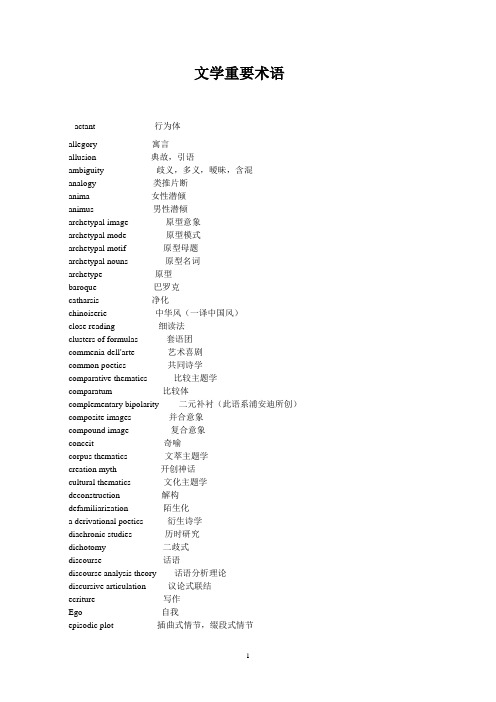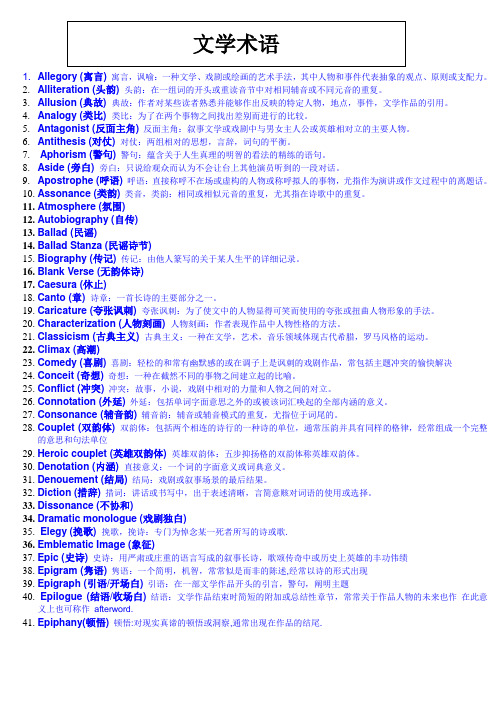文学术语汇编
- 格式:doc
- 大小:64.50 KB
- 文档页数:14

中文文学术语
1.叙事-指文本中叙述故事的方式和手法,包括时间序列、情感表达、人物塑造等方面。
2. 描写 - 指文本中对人物、物品、场景等进行具体生动的描述,展现出视觉、听觉、嗅觉、味觉等方面的细节。
3. 意象 - 指文本中使用形象的语言表达出来的抽象概念,如比喻、拟人等手法。
4. 比喻 - 指通过对两个事物的相似点进行比较,以达到给读者新的感受或理解的修辞手法。
5. 拟人 - 指将无生命的事物赋予人类的特征和行为,来表达作者的情感或增强作品的艺术效果。
6. 反讽 - 指通过说出与实际相反的话,以表达出作者的反感、批评或嘲讽。
7. 对比 - 指通过对两个相似或不同的事物进行对照,来突出文本中的主题、情感等。
8. 押韵 - 指文本中出现两个或多个音节相同的词汇,以增强诗歌、歌曲等的韵律美感。
9. 音律 - 指文本中音节的节奏、语调、音量等方面的组合,以产生艺术效果。
10. 主旨 - 指文本中的核心思想和主题,是作者所要表达的意义和观点。
- 1 -。

⽂学古诗词曲名词术语⼤全⼴东省作家协会主席蒋述卓题【诗⾔志】我国古代诗论家对诗歌本质的⼀种理解。
最早⼤约记载于《尚书尧典》。
在春秋战国时代,诸⼦均有所论及,但各家的理解已不尽⼀致。
汉代以后,逐渐形成三种说法。
⼀种偏重于'志',是指诗⼈主观的思想认识;⼀种偏重于'情',是指主观的情;更多的诗论家则认为诗歌是抒发思想感情的,志和情并重。
【思⽆邪】原句出于《诗经鲁颂駉》最后⼀章。
春秋战国时代孔⼦⽤来评价《诗经》的总的思想倾向。
'诗三百,⼀⽅以蔽之,⽈:思⽆邪'。
(《论语为政》)所谓'⽆邪',就是'归于正',亦就是合乎封建正统礼教的意思。
【兴、观、群、怨】春秋战国时代哲学家孔⼦对诗歌创作的社会作⽤的论述。
记载于《论语阳货》。
历代诗论家对于这个论述作过不少阐述。
⼤致上说,兴,是指诗歌的美感作⽤,观,是指诗歌的认识作⽤,通过它可以观风俗、识得失;群,是指诗歌的教育团结作⽤,沟通⼈们的情感;怨,是指诗歌的宣洩作⽤,特别是对社会政治的议论和讽喻。
【温柔敦厚】最早记载于《礼记经解》。
'温柔敦厚,诗教也'。
这是儒家的诗歌理论的核⼼思想。
认为诗歌有着教化作⽤,能使⼈们的思想⾏为符合于特定的封建伦理道德规范,这种理论长期影响着中国古典诗歌的理论和创作,产⽣了严重的消极影响。
【诗六义】专指《诗经》的'六义'。
最早记载于《周礼春官》,汉代《⽑诗序》中明确提出:'故诗有六义焉:⼀⽈风,⼆⽈赋;三⽈⽐,四⽈兴,五⽈雅,六⽈颂。
'对于'六义'的解释,有着⼀个历史发展过程。
唐代孔颖达提出了'三体''三法'的说法,也就是将'六义'分为两组,'风''雅''颂'这三者是指体裁,'赋''⽐''光'这三者是作法。

文学术语Terms in English Literature1.Allegory (寓言)A tale in verse or prose in which characters, actions, or settings represent abstract ideas or moral qualities.寓言,讽喻:一种文学、戏剧或绘画的艺术手法,其中人物和事件代表抽象的观点、原则或支配力。
2.Alliteration (头韵)Alliteration is the repetition of the same initial consonant sound within a line or a group of words.头韵:在一组词的开头或重读音节中对相同辅音或不同元音的重复。
3.Allusion (典故)A reference to a person, a place, an event, or a literary work that a writer expects the reader to recognize and respond to.典故:作者对某些读者熟悉并能够做出反映的特定人物,地点,事件,文学作品的引用。
4.Analogy (类比)A comparison made between two things to show the similarities between them.类比:为了在两个事物之间找出差别而进行的比较。
5. Antagonist (反面主角)The principal character in opposition to the protagonist or hero or heroineof a narrative or drama.反面主角:叙事文学或戏剧中与男女主人公或英雄相对立的主要人物。
6. Antithesis (对仗)The balancing of two contrasting ideas, words, or sentences.对仗:两组相对的思想,言辞,词句的平衡。

文学重要术语actant 行为体allegory 寓言allusion 典故,引语ambiguity 歧义,多义,暧昧,含混analogy 类推片断anima 女性潜倾animus 男性潜倾archetypal image 原型意象archetypal mode 原型模式archetypal motif 原型母题archetypal nouns 原型名词archetype 原型baroque 巴罗克catharsis 净化chinoiserie 中华风(一译中国风)close reading 细读法clusters of formulas 套语团commenia dell'arte 艺术喜剧common poetics 共同诗学comparative thematics 比较主题学comparatum 比较体complementary bipolarity 二元补衬(此语系浦安迪所创)composite images 并合意象compound image 复合意象conceit 奇喻corpus thematics 文萃主题学creation myth 开创神话cultural thematics 文化主题学deconstruction 解构defamiliarization 陌生化a derivational poetics 衍生诗学diachronic studies 历时研究dichotomy 二歧式discourse 话语discourse analysis theory 话语分析理论discursive articulation 议论式联结ecriture 写作Ego 自我episodic plot 插曲式情节,缀段式情节explicative thematics 阐释主题学extrinsic studies 外部研究fable (有关动物的)寓言fiction 虚构,小说formal realism 形式写实主义formula 套语formulaic expression 套语语句Formulaic Theory 套语理论function 功能genology 文类学genre, or literary genre 文类(即文学类型),体裁heterogeneity 非均一性the High Baroque 鼎盛巴罗克high mimetic 高模仿型Id 本我an illusion of reality 现实的幻象image 意象imagism 意象主义impersonal personality 无个性的个性interdisciplinary study 跨学科研究intersubjectivity 主体间性intertexts 交互文本intertextuality 文本间性irony 反讽itineraria 巡游juxtaposition of imagery 意象并置langue 语言larger-than-life 大于生活lexie 语汇单位leitmotif 主导母题linguistics 语言学linked plot 缀合情节literariness 文学性local texture 局部肌质locus amoenus 安乐之所logical structure 逻辑结构low mimetic 低模仿型the Mannerist style 矫饰主义风格meaning 意旨melodrama 情节剧metacriticism 元批评metafiction 元小说metalanguage 元语言metaphor 暗喻,比喻the Metaphysical style 玄学派风格metonymy 换喻,转喻mirage 幻象model 范型monomyth 单一神话motivation 动因化multiple periodicity 多项周旋(此语系浦安迪所创)mythemes 神话素Mythology 神话体系narrative code 叙事语码narrative syntagms 叙事性横组合段narratology 叙事学objective correlative 客观对应物Oedipus complex 俄狄浦斯情结oral inconsistency 口述出岔overtone 弦外之音(本意为陪音、泛音)oxymoron 矛盾修辞parable 说教寓言paradigmatic 纵聚合的paradox 悖论parody 谐摹parole 言语paronomasia 双关personality 个性,个人性philology 语文学the poetics of discontinuity 非连续诗学point of view 视点pragmatics 语用学the primordial image 原始意象the principle of equivalence 对等原则problematic individuals 疑难人物proseroman 散文传奇pseudo-statement 伪陈述Psychoanalysis 精神分析学raports de fait 实际联系retroactive reading 回味阅读rhapsody 赋saga 英雄传奇semantic formulas 语义套语semantics 语义学semiotics, semiology 符号学shadow 阴影(心理学术语)showing 显示signified 所指signifier 能指simile 明喻Stoffgeschichte 题材史stylistics 风格学Superego 超我symbol 象征symple image 单纯意象synaesthesia 联觉,通感synchronic studies 共时研究syntactic formulas 句法套语syntactics 句法学syntagmatic 横组合的syntax 句法telling 讲述tenor 喻旨tension 张力textuality 本文性thematics, thematology 主题学theme 套式(套语理论所用;暂译名)topoi 惯用话题,老套话tristia 忧郁type scenes 典型场景unitary plot 单一情节vehicle 喻体a vision of reality 现实幻象vorticism 旋涡主义Weniad 文王史诗(此词系王靖献所创)。

1. Allegory (寓言)寓言,讽喻:一种文学、戏剧或绘画的艺术手法,其中人物和事件代表抽象的观点、原则或支配力。
2.Alliteration (头韵) 头韵:在一组词的开头或重读音节中对相同辅音或不同元音的重复。
3.Allusion (典故) 典故:作者对某些读者熟悉并能够作出反映的特定人物,地点,事件,文学作品的引用。
4.Analogy (类比) 类比:为了在两个事物之间找出差别而进行的比较。
5.Antagonist (反面主角)反面主角:叙事文学或戏剧中与男女主人公或英雄相对立的主要人物。
6.Antithesis (对仗) 对仗:两组相对的思想,言辞,词句的平衡。
7. Aphorism (警句)警句:蕴含关于人生真理的明智的看法的精练的语句。
8.Aside (旁白) 旁白:只说给观众而认为不会让台上其他演员听到的一段对话。
9.Apostrophe (呼语)呼语:直接称呼不在场或虚构的人物或称呼拟人的事物,尤指作为演讲或作文过程中的离题话。
10.Assonance (类韵)类音,类韵:相同或相似元音的重复,尤其指在诗歌中的重复。
11.Atmosphere (氛围)12.Autobiography (自传)13.Ballad (民谣)14.Ballad Stanza (民谣诗节)15.Biography (传记)传记:由他人篆写的关于某人生平的详细记录。
16.Blank Verse (无韵体诗)17.Caesura (休止)18.Canto (章) 诗章:一首长诗的主要部分之一。
19.Caricature (夸张讽刺) 夸张讽刺:为了使文中的人物显得可笑而使用的夸张或扭曲人物形象的手法。
20.Characterization (人物刻画) 人物刻画:作者表现作品中人物性格的方法。
21.Classicism (古典主义) 古典主义:一种在文学,艺术,音乐领域体现古代希腊,罗马风格的运动。
22.Climax (高潮)edy (喜剧)喜剧:轻松的和常有幽默感的或在调子上是讽刺的戏剧作品,常包括主题冲突的愉快解决24.Conceit (奇想)奇想:一种在截然不同的事物之间建立起的比喻。

中国现当代文学名词解释汇编(最新版)中国现当代文学名词解释汇编1.时务体以康有为、梁启超为代表的维新派报刊政治家继承王韬报刊政论的传统,在政论写作中不断突破框框进行革新,逐渐形成了一种新的报章文体。
这种文体以梁启超在《时务报》上发表的政论最为典型,故被称为“时务文体”。
又称“新文体”、“报章体”,是一种不同于桐城派古文的比较通俗浅显的文体。
这种文体特征为:半文半白,平易畅达,语言丰富、笔调自由、条理清晰、笔锋常带感情。
其历史渊源:既是汉魏无文风的发扬也是思想解放的产物。
它的社会效果:令读者开眼,风靡一时,并为后世政论报纸纷纷效仿。
而守旧的老辈则痛恨它。
2.诗界革命(暨南大学05年)即戊戌变法前后的诗歌改良运动。
诗界革命冲击了长期统治诗坛的拟古主义、形式主义倾向,要求作家努力反映新的时代和新的思想,部分新体诗语言趋于通俗,不受旧体格律束缚,这些在当时都起了解放诗歌表现力的作用。
但是,梁启超等强调保持旧风格,这就又束缚了手脚,使得它只是旧瓶装新酒,在中国古典诗歌的改革上虽有前进,却前进不大。
3.小说界革命(安师大03年)光绪二十八年十月(1902年11月),《新小说》杂志在日本横滨创刊。
梁启超在《论小说与群治之关系》中,提出了“今日欲改良群治,必自小说界革命始,欲新民,必自新小说始”的口号,这是“小说界革命”的开始。
“小说界革命”的影响相当深远,许多人投身于小说创作,直接促使了创作热潮的出现,在近代小说史上占据了极为重要的地位。
4.南社(苏州大学06年,中山大学12年,南开大学01年)是一个曾经在中国近现代史上产生过重要影响的资产阶级革命文化团体,是中国近代文学史上规模最大的文学社团。
该团体于1909年11月13日在苏州成立,发起人为同盟会会员陈去病、高旭和柳亚子。
1917年,因对“同光体”的评价发生争论,南社内部开始分裂。
1923年,南社解体。
以后又有新南社和南社湘集﹑闽集等组织。
前后延续30余年。
中国文学术语集
以下是一些中国文学术语的集合:
1. 诗歌体裁:
- 诗:表达情感、描绘景物和抒发思想的文学形式。
- 词:以短小精悍的形式表达情感的文学形式。
- 曲:以歌唱为主的文学形式。
- 赋:以描写或抒发感情为主的文学形式。
2. 修辞手法:
- 比喻:用一种事物来比喻另一种事物,以增强表达的艺术性和形象性。
- 拟人:赋予非人物以人的特征和行为,增加情感共鸣。
- 夸张:夸大事物的特征或程度,以增强表达的效果。
- 排比:通过列举相同结构的词语或短语来加强表达的力度。
3. 修辞格:
- 对偶:用相同或相似的词语、短语或句子结构来表达对立或相反的意思。
- 反问:用疑问句的形式来表达肯定或否定的意思。
- 押韵:在诗歌中使用相同或相似的音韵来增加韵律感。
4. 现象:
- 平仄:指汉字的声调高低变化。
- 押韵:在诗歌中使用相同或相似的音韵来增加韵律感。
- 韵律:诗歌中的节奏和音乐感。
5. 文学流派:
- 唐诗:盛行于唐朝的诗歌形式,以七言绝句为主要形式。
- 宋词:盛行于宋朝的短小精悍的诗歌形式。
- 元曲:盛行于元朝的戏剧形式,以曲子和对白相结合的形式。
这只是一些中国文学术语的集合,还有许多其他的术语和概念,用于描述和分析中国文学作品和文学创作的特点和风格。
1. Allegory is a tale in verse or prose in which characters, actions, or settings represent abstract ideas or moral qualities.寓言是写成诗歌或散文形式的小故事其中人物、事件和场景代表抽象的观点或道德品质。
2. Alliteration is the repetition of the same initial consonant sound within a Line or a group of words.头韵是指在一行或一组词中第一个重读辅音的重复。
3. Allusion is reference to a person, a place, an event, or a literary work that a writer expects the reader to recognize and respond to.典故是作者对某些读者熟悉并能够作出反应的特定人物、地点、事件、文学作品的引用。
4. Analogy is a comparison made between two things to show the similarities between them.类比是为了在两个事物之间找出相似之处而进行的比较5. Antagonist is the principal character in opposition to the protagonist or hero or heroine of a narrative or drama.反面主角是叙事文学或戏剧中与男女主人公或正面人物相对立的主要人物6. Antithesis: the balancing of two contrasting ideas, words, or sentences.对仗指两组相对的思想、言辞、词句的平衡。
文学术语1 反讽又称倒反法、反语,英文名irony,为说话或写作时一种带有讽刺意味的语气或写作技巧,单纯从字面上不能了解其真正要表达的事物,而事实上其真正原本的意义正好是字面上所能理解的意涵的相反,通常需要从上下文或语境来了解其用意。
反讽最明显的特征就是言非所指,也就是一个陈述的实际内涵与它表面意义相互矛盾;从技巧运用上看,可分为夸大叙述、正话反说、诗论等。
其代表作品为德国诗人海森毕特尔的《那又怎样》、浦柏的《论人》、李商隐的《贾生》。
2浪漫主义浪漫主义是文艺的基本创作方法之一,与现实主义同为文学艺术上的两大主要思潮。
在反映客观现实上,侧重从主观内心世界出发,抒发对理想世界的热烈追求,常用热情奔放的语言、瑰丽的想象和夸张的手法来塑造形象。
许多知识分子和历史学家将浪漫主义视为是对于启蒙运动的反弹,是一种对启蒙时代的反思。
启蒙时代的思想家强调演绎推理的绝对性,而浪漫主义则强调直觉、想象力、感觉,甚至到了被一些人批评为“非理性主义”的程度。
它是由欧洲在18世纪晚期至19世纪初期出现的许多艺术家、诗人、作家、音乐家、以及政治家、哲学家等各种人物组成,其详细特征和定义一直到20世纪都仍是思想史和文学史界争议的题材。
其特征主要有:1 偏重于表现主观理想,抒发强烈的个人感情;2 描写自然风光,歌颂大自然;3 酷爱描写中世纪和以往的历史;4 重视民间文学,尤其是中世纪民间文学。
其代表是布莱克、华兹华斯《抒情歌妖姬》、科勒律治、拜伦、雪莱《西风颂》、普希金、贝多芬《第五交响曲》、肖邦、雨果《悲惨世界》、欧文《睡谷传说》、麦尔维尔《白鲸》、司格特《艾凡赫》、屈原《离骚》、李白《将进酒》、郭沫若3 清教主义清教主义起源于英国,在北美得以实践和发展。
其因信称义、天职思想、山巅之城等核心理念虽然构成宗教行为规范要素,却在很大程度上起到了消解禁锢人们思想和行为的主流教会传统的作用,促进了社会世俗化进程。
在早期的美国,推动力个性解放,促成建立现代劳动、职业和财富观,以宗教的理想勾勒出国家未来追求的目标。
文学术语汇编(考研用)1Literature of the absurd: (荒诞派文学) The term is applied to a number of works in drama and prose fiction which have in common the sense that the human condition is essentially absurd, and that this condition can be adequately represented only in works of literature that are themselves absurd. The current movement emerged in France after the Second World War, as a rebellion against essential beliefs and values of traditional culture and traditional literature. They hold the belief that a human being is an isolated existent who is cast into an alien universe and the human life in its fruitless search for purpose and meaning is both anguish and absurd.Theater of the absurd: (荒诞派戏剧) belongs to literature of the absurd. Two representatives of this school are Eugene Ionesco, French author of The Bald Soprano (1949) (此作品中文译名<秃头歌女>), and Samuel Beckett, Irish author of Waiting for Godot (1954) (此作品是荒诞派戏剧代表作<等待戈多>). They project the irrationalism, helplessness and absurdity of life in dramatic forms that reject realistic settings, logical reasoning, or a coherently evolving plot.Black comedy or black humor: (黑色幽默) it mostly employed to describe baleful, naïve, or inept characters in a fantastic or nightmarish modern world playing out their roles in what Ionesco called a “tragic farce”, in which the events are often simultaneously comic, horrifying,and absurd. Joseph Heller’s Catch-22 (美国著名作家约瑟夫海勒<二十二条军规>) can be taken as an example of the employment of this technique.文学术语汇编24. Aestheticism or the Aesthetic Movement(唯美主义): it began to prevail in Europe at the middle of the 19th century. The theory of “art for art’s sake”was first put forward by some French artists. They declared that art should serve no religious, moral or social purpose. The two most important representatives of aestheticists in English literature are Walt Pater and Oscar Wilde.5. Allegory(寓言): a tale in verse or prose in which characters, actions, or settings represent abstract ideas or moral qualities, such as John Bunyan’s The Pilgrim’s Progress. An allegory is a story with two meanings, a literal meaning and a symbolic meaning.6. Fable(寓言): is a short narrative, in prose or verse, that exemplifies an abstract moral thesis or principle of human behavior. Most common is the beast fable, in which animals talk and act like the human types they represent. The fables in Western cultures derive mainly from the stories attributed to Aesop, a Greek slave of the sixth century B. C.7. Parable(寓言): is a very short narrative about human beings presented so as to stress analogy with a general lesson that the narrator is trying tobring home to his audience. For example, the Bible contains lots of parables employed by Jesus Christ to make his flock understand his preach.(注意以上三个词在汉语中都翻译成语言,但是内涵并不相同,不要搞混)8. Alliteration(头韵): the repetition of the initial consonant sounds. In Old English alliterative meter, alliteration is the principal organizing device of the verse line, such as in Beowulf.9. Consonance is the repetition of a sequence of two or more consonants but with a change in the intervening vowel, such as “live and love”.10. Assonance is the repetition of identical or similar vowel, especially in stressed syllables, in a sequence of nea rby words, such as “child of silence”.11. Allusion (典故)is a reference without explicit identification, to a literary or historical person, place, or event, or to another literary work or passage. Most literary allusions are intended to be recognized by the generally educated readers of the aut hor’s time, b ut some are aimed at a special group.12. Ambiguity(复义性): Since William Empson(燕卜荪)published Seven Types of Ambiguity(《复义七型》), the term has been widely used in criticism to identify a deliberate poetic device: the use of a single word or expression to signify two or more distinct references, or to express twoor more diverse attitudes or feeling.文学术语汇编313. Antihero(反英雄):the chief character in a modern novel or play whose character is totally different from the traditional heroes. Instead of manifesting largeness, dignity, power, or heroism, the antihero is petty, passive, ineffectual or dishonest. For ex ample, the heroine of Defoe’s Moll Flanders is a thief and a prostitute.14. Antithesis(对照):(a figure of speech) An antithesis is often expressed in a balanced sentence, that is, a sentence in which identical or similar syntactic structure is used to express contrasting ideas. For example, “Marriage has many pains, but celibacy(独身生活)has no pleasures.”by Samuel Johnson obviously employs antithesis.15. Archaism(拟古):the literary use of words and expressions that have become obsolete in the common speech of an era. For example, the translators of the King James V ersion of Bible gave weight and dignity to their prose by employing archaism.16. Atmosphere(氛围): the prevailing mood or feeling of a literary work. Atmosphere is often developed, at least in part, through descriptions of setting. Such descriptions help to create an emotional climate to establish the reader’s expectations and attitudes.文学术语汇编417. Ballad(民谣):it is a song, transmitted orally, which tells a story. It originated and was communicated orally among illiterate or only partly literate people. It exists in many variant forms. The most common stanza form, called ballad stanza is a quatrain in alternate four- and three-stress lines; usually only the second and fourth lines rhyme. Although many traditional ballads probably originated in the late Middle Age, they were not collected and printed until the eighteenth century.18. Climax:as a rhetorical device it means an ascending sequence of importance. As a literary term, it can also refer to the point of greatest intensity, interest, or suspense in a story’s turning point. The action leading to the climax and the simultaneous increase of tension in the plot are known as the rising action. All action after the climax is referred to as the falling action, or resolution. The term crisis is sometimes used interchangeably with climax.19. Anticlimax(突降):it denotes a writer’s deliberate drop from the serious and elevated to the trivial and lowly, in order to achieve a comic or satiric effect. It is a rhetorical device in English.20. Beat Generation(垮掉一代):it refers to a loose-knit group of poets and novelists, writing in the second half of the 1950s and early 1960s, who shared a set of social attitudes –antiestablishment, antipolitical, anti-intellectual, opposed to the prevailing cultural, literary, and moral values, and in favor of unfettered self-realization and self-expression.Representatives of the group include Allen Ginsberg, Jack Kerouac and William Burroughs. And most famous literary creations produced by this group should be Allen Ginsberg’s long poem Howl and Jack Kerouac’s On the Road.文学术语汇编521. Biography(传记):a detailed account of a person’s life written by another person, such as Samuel Johnson’s Lives of the English Poets and James Boswell’s Life of Samuel Johnson.22. Autobiography(自传):a person’s account of his or her own life, such as Benjamin Franklin’s autobiography.24. A parody(模仿)imitates the serious manner and characteristic features of a particular literary work, or the distinctive style of a particular author, or the typical stylistic and other features of a serious literary genre, and deflates the original by applying the imitation to a lowly or comically inappropriate subject.第23个应该是blank verse但系统总说含有不允许的关键字,所以一直发不上来,很郁闷,我把目前编好的一起发到公开邮箱去,大家到那里下载。